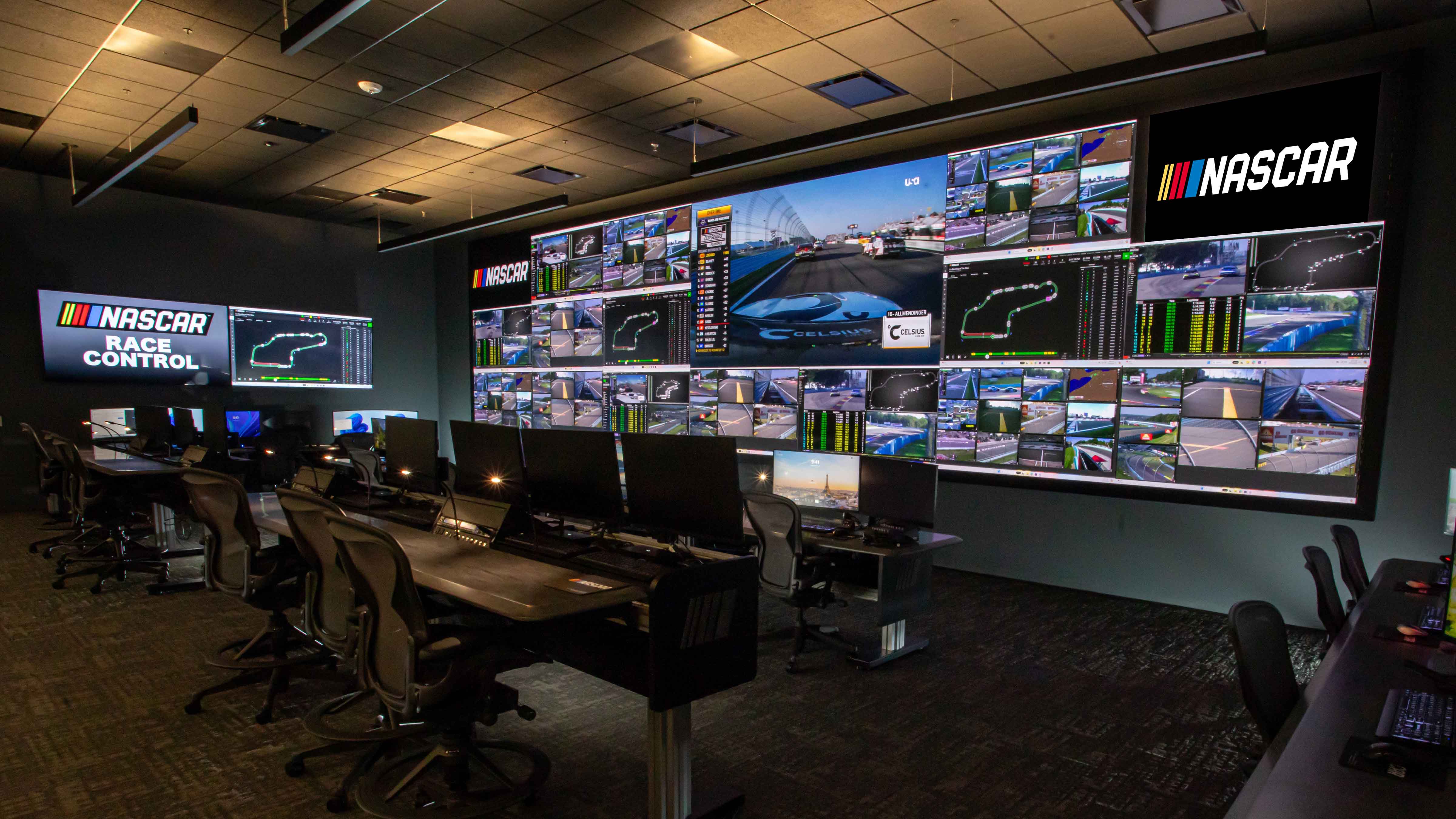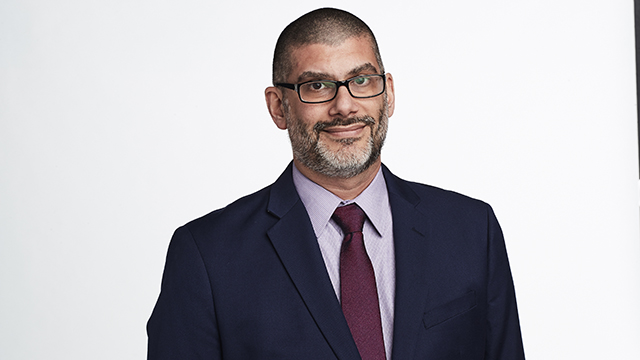The 2025 NASCAR Cup Series chase is underway, and it's bringing an enhanced era of competition to the circuit with the help of FusionTECH and Samsung, which is now an official NASCAR Technology Partner. Using a slew of Samsung displays, including a 32x9-foot The Wall microLED display, NASCAR officiating is rising to a whole new level.
[Brewing Up Effective Digital Signage]
The 2025 season sees the introduction of the NASCAR Productions Remote Race Control Room. Located in Concord, NC, at NASCAR's 58,00-square-foot production facility, the control room is reinventing how races are officiated. Samsung and its clear, massive display technology was the ideal fit for achieving the ultimate goal.
"NASCAR is a technology-forward organization with highly modern core networks, servers, media, event, venue, and racing function applications," said David Phelps, head of display division, Samsung Electronics America. "Key goals of the partnership between [Samsung and NASCAR] included reducing travel costs for officials by enabling remote race management and creating the opportunity for NASCAR to introduce a new Remote Race Control Entitlement sponsorship, potentially opening new revenue streams. Overall, the collaboration was designed to address NASCAR’s evolving needs while boosting efficiency and flexibility when officiating large-scale races."
So, what's under the proverbial hood and how did it all come together? SCN went inside to find out.
Kiss the Wall
A project of this magnitude may seem like it took forever to come together, but that was hardly the case. In fact, it was initiated in March 2024 and the The Wall installation was completed in August 2024. The control room was fully operational with all the displays for the 2025 NASCAR season-opening Cook Out Clash at Bowman Gray Stadium on Feb. 2.
FusionTECH, a sports and entertainment technology consulting agency based in West Hollywood, CA, was selected for the project. The company was founded in 2021 by CEO Brandon McNulty, who is the former CTO of the International Speedway Corporation, and he said there's more driving the control room than just The Wall. Two 85-inch LED displays are positioned on opposite sides of The Wall, and there are additional monitors at each workstation within the control room."
"This is the first time The Wall has been used for remote officiating," McNulty explained. "The monitors in race control are used to assist with officiating and data analysis. The officials leverage the monitors for an up-close look when analyzing pit stops, calling penalties, and infractions. Footage can also be broadcast from the monitors to The Wall, providing a larger-than-life perspective for replay analysis.”
As the technology partner, Samsung was ideal in enhancing the officiating experience. "Pre-Samsung screens, all officials traveled to the track to do their jobs," explained Steve Stum, NASCAR VP operations and technical production. "Keeping officials at home gives them a better quality of life by not traveling and being away from family, but also the resolution of the screen keeps them engaged in their jobs using current technology."
There are a total of 37 Samsung products in the remote race control room. "The initiative aimed to mirror systems in other professional sports leagues, like the NFL’s Remote Officiating, to modernize and streamline NASCAR’s processes," Phelps said. "The remote race control room also integrates 25 models of the 27-inch ViewFinity S6 monitor and seven 49-inch Odyssey G9 ultra-wide curved monitors for racing officials to gather and analyze data about track operations.”
Those curved monitors showed that attention to detail was taken to make officials lives easier and thus provide a better race-day experience for fans and everyone involved. McNulty said NASCAR requested curved monitors because they are more comfortable on the eyes during long hours of continuous viewing. They also maximize desk space, since officials previously used two monitors and now had one ultra-wide display that could show two frames on a single screen.
"This room allows the NASCAR officials to use more modern technology for replays, data mining, communications, etc.," said Stum. "The resolution of the screen gives them the confidence and feeling just like they are at the track. With up to 200 video inputs and all the driver radios at their disposal, we now have better ability at the track to look at content and feed that information back to race control on site to help make officiating more accurate and faster."
Of course, the star of the show is The Wall, with its visual clarity and scale enhancing the precision and efficiency of race-day operation. Per Phelps, the screen allows up to 24 officials in the control room to review video footage and accurately officiate races from a distance.
"Its larger-than-life picture quality and seamless integration with other technologies make it an essential tool for NASCAR’s move toward remote officiating, ensuring that race decisions are made faster and with more clarity than if officials were to be physically present at the track," he added. "This innovation is a key step in enhancing the fan experience and improving NASCAR's operational capabilities."
A Heat Race
Considering all the technology that had to be installed within such a short window, there must have been some challenges, right? Not necessarily.
"Thanks to careful planning and The Wall’s flexible design, the actual installation went off without a hitch," McNulty admitted. "NASCAR prepped the surface with plywood to ensure it could support the mounts. The biggest consideration was making sure the surface area for the installation was flat and even. NASCAR installed adjustable custom mounts that allowed for the eventual installation of The Wall to be much easier."
It is mind boggling that with all those displays running that the room isn't akin to a sauna. To McNulty and his team's surprise, the heat generated by The Wall itself was much lower than expected. To optimize cooling, FusionTECH simply installed custom frames around the screen, with carefully placed vents at the top and bottom to pull air through the screen and keep it cool.
Dedicated air handlers were put in place to manage the technical side of the building, while extra exhaust and recirculation systems were incorporated to help expel the heat from the control room. “The facility was built with the understanding that a large screen would eventually be installed," McNulty confirmed. "As a result, extra care was taken to ensure proper ventilation and heat management."
Another step—or lack thereof—that made for a seamless collaboration and installation was that NASCAR and FusionTECH focused on ensuring the existing equipment integrated with the new technology. The cameras, for example, were previously part of the officiating setup at the tracks, so no new ones were needed. “NASCAR worked directly with the production teams from all major networks like FOX, NBC, and The CW to integrate high-quality 1080p HDR cameras that feed into the replay system and onto The Wall," McNulty explained.
Victory Lane
Officiating from the control room is just the tip of the iceberg for NASCAR and beyond. Thinking about the future for NASCAR, Stum said there could be instances down the road where a reporter or maybe an official could join the broadcast live from the room and give the perspective of the officials to the home viewers. "I think that gives the viewers an opportunity to look behind the curtain into what goes on from and officials point of view," he said.
[The Integration Guide to Video Walls 2025]
According to Stum, the NASCAR Productions Remote Race Control Room offers a lot of potential and a huge opportunity for the organization to capitalize on technology. "The new race control has been great to get up and going," he added. "The number of views of cameras that we didn’t have before will give us the ability to mine data and look for infractions that we never had before. The response of the officials has been overwhelmingly positive. From the moment you walk into the room you can see what it can provide to the officials to help with their jobs."

